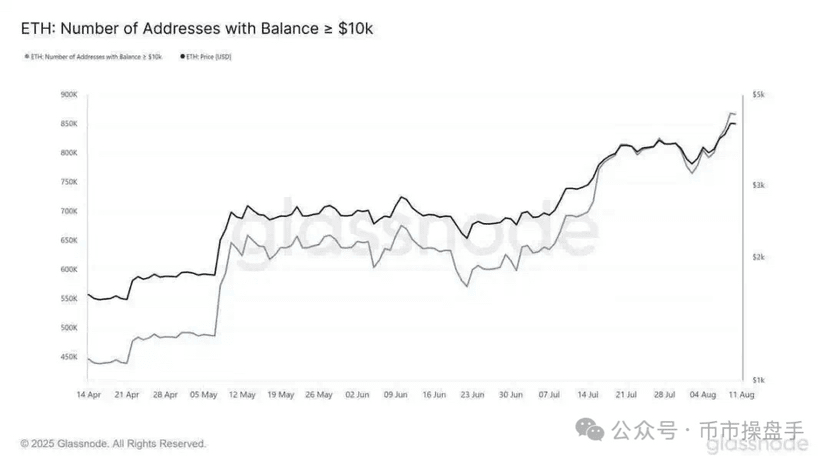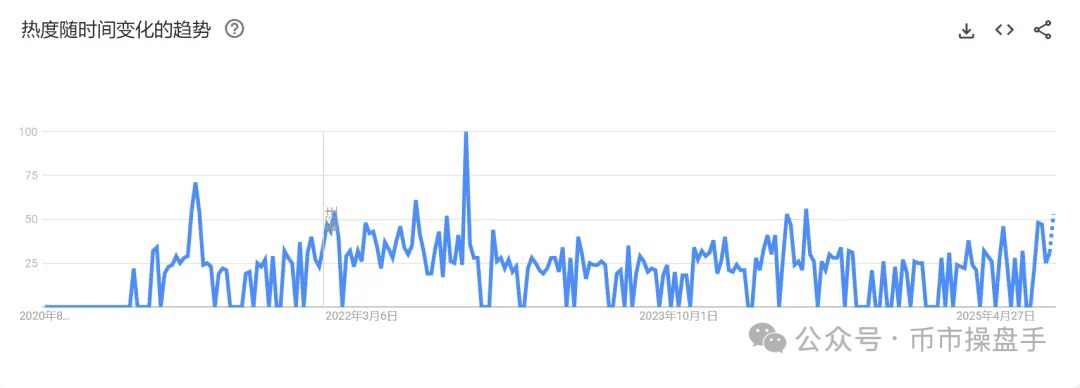In the past four months, Ethereum's price has soared from $1380 to $4360, an increase of 216%, making it one of the best-performing assets globally. However, it is quite unusual that this traditional 'retail paradise' has turned into an institutional carnival in this round of market movement. The latest data shows that institutional holdings are growing at an unprecedented rate — according to Strategicethreserve data, as of August 12, 70 institutional treasury and Ethereum ETFs held a total of 9.49 million ETH, accounting for 7.85% of the circulating supply. Even more strikingly, Glassnode's on-chain data shows that this price increase aligns closely with the movements of 'medium and large holders': when Ethereum broke through the $4200 mark, the number of addresses holding over $10,000 in ETH surged to 868,886, a nearly 13-month high. This series of data indicates that the market structure is undergoing a fundamental shift, with institutional investors becoming the main driving force behind this bull market.

To some extent, this round of Ethereum's bull market can be considered the ultimate test for 'true believers' — very few investors have been able to hold their positions during such rapid price increases. A typical case is quite lamentable: the established crypto investment firm Abraxas Capital once bottomed out in the $1600-1800 range but locked in profits through futures at around $2300, resulting in the loss of subsequent major uptrends, leading to a loss of over $140 million on their ETH hedge. More dramatically, the co-founder of BitMEX, who has repeatedly predicted that Ethereum will break through $10,000, misjudged the market at $3500 to fall below $3000, ultimately being forced to cover their position at a high of $4200. The collective misjudgment of these 'market veterans' precisely illustrates the difficulty of maintaining composure in extreme market conditions.

There is a typical cognitive bias in the current market: some 'fundamentalists' simply attribute this round of Ethereum's rise to capital speculation, arguing that the price surge is not in sync with the improvement in network indicators. This analytical framework may hold in traditional markets but completely misunderstands the pricing mechanism of crypto assets — in emerging asset classes, price is not a lagging indicator of fundamentals but rather the most forward-looking catalyst.
The rise of Solana is the most convincing: when SOL soared from $7.8 to $130, the network effects began to accelerate — the developer ecosystem exploded, and the user base grew exponentially, ultimately giving rise to the prosperity of Meme trading platforms like Pumpfun. This path clearly confirms the unique laws of the crypto market: price breakthroughs create narratives, narratives attract capital, and capital drives ecological development.
In fact, the phenomenon of 'price leading fundamentals' is very common in innovative assets. Looking back in history, when Amazon's stock price rose 194% in 2003, its PE was still negative; during Tesla's 344% rise in 2013, quarterly delivery volumes only grew by 25%. These cases all demonstrate that disruptive technology assets often go through a 'expectation-driven' price discovery phase.
For Ethereum, the current price increase is merely the first round of value reassessment driven by the dual benefits of the (GENIUS Act) regulatory framework and the 'Project Crypto' institutional strategy. This wave of market movement primarily reflects policy expectations, while substantial market movements based on improvements in network fundamentals (such as increased GAS consumption and larger TVL) are still brewing. However, it must be clearly understood: the current price reflects the market's expectations for the future. When on-chain indicators show significant improvement, it often means that market expectations have already been fully priced, and the trend may be nearing its end.
For a large number of investors who missed the boat, the current difficult choice is: can we buy in! Although we do not recommend chasing the price, from a trend perspective, the risk of buying in now is not large, mainly for two reasons:
1. Once a trend is established, it often has very strong inertia — unless there is sufficient bullish release, it is difficult to reverse. As long as the rise has not experienced a phase of accelerated volume, the likelihood of a short-term peak is low.
2. Every bull market relies on the participation of retail investors, who often go through four psychological stages: observation period (doubting the authenticity of the market) → hesitation period (afraid of missing out and afraid of a pullback) → accumulation period (buying in batches in anxiety) → frenzy period (fully invested in chasing highs). Currently, Google's search interest in 'Ethereum' is only 40% of its historical peak, the growth rate of small on-chain address holdings is slow (not yet at the distribution stage), and Ethereum's rise has not been widely discussed on social media. These signs indicate that retail investors have not yet entered the market in large numbers, and the market is likely still in the second stage.

Although there is no need to fear heights in terms of trends, one should still avoid chasing prices in operations; the timing for buying should ideally be chosen during market pullbacks — after all, bull markets often have sharp declines (buying points during daily sharp dips), lowering the average cost of entry to maximize returns.